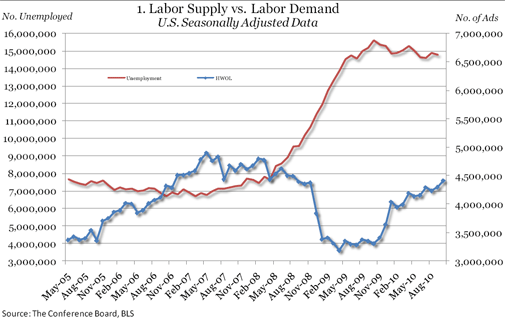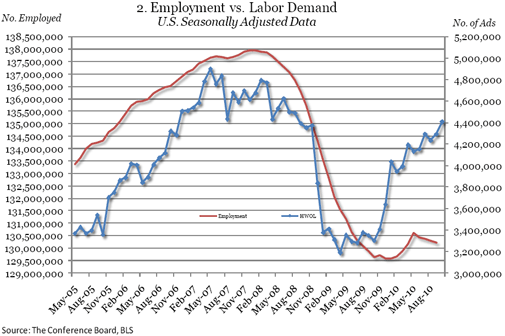- Economy continues its moderate upward trend in labor demand with online vacancies up by 1.1 million since the official end of the recession (June 2009)
- 40 out of 50 States post gains in online job demand in October
- October demand up for healthcare practitioners and technical workers, management workers, and computer and mathematical science workers
“In this slow economic recovery, the October rise is welcome news that the trend in labor demand continues to move in a positive direction, albeit at a very moderate pace,” said June Shelp, Vice President at The Conference Board. “The October increase reflected a moderate rise in a range of occupations and geographically across the nation. The slow but steady upward trend of the last seven months points to modest growth in employment through the end of 2010.”


REGIONAL AND STATE HIGHLIGHTS
- Modest gains in October experienced in all 4 regions and all but 4 of the largest States
The West experienced the largest October gain, 47,800. California was the largest contributor with an increase of 32,100. California’s gain was largely due to increases in demand for computer and math jobs and management jobs. Washington bounced back from last month’s loss and gained 7,400. Arizona and Colorado gained 4,700 and 4,100 respectively in October. Among the smaller States, Nevada gained 2,400 in October and experienced its third consecutive month of increases. Oregon rose 1,500, Hawaii gained 700, Alaska rose 500, and New Mexico gained 400.
The Midwest experienced the second largest gain for this month, 41,200. In October, Ohio rose 11,500 to 151,600. Ohio has shown solid gains since December 2009. This month’s gains are largely due to increases in demand for healthcare practitioners and technical workers and computer and math jobs. Labor demand in Illinois rose 10,600, largely due to increases in demand for management jobs, computer and math jobs, and healthcare practitioners and technical workers. Michigan continues to show slow and steady improvement and rose 5,200 to 107,600. Wisconsin gained 4,100. Minnesota continues to grow and rose 3,600 this month. Missouri rose 2,100. Among the States with smaller populations, North Dakota gained 500 while Indiana lost a slim 100.
The South increased by 19,900 in October, reflecting gains in three out of the six large States. Georgia had the most significant gain in the South with an increase of 11,900, largely reflecting increases in demand for management jobs and healthcare practitioners and technical workers. Texas increased by 8,500 largely due to job demand in computer and math occupations. Florida was about unchanged in October (+800). Virginia dropped 3,400, continuing its decline of the last three months. Maryland dropped for the third month and was down 2,800 in October. North Carolina fell 600. Among the less populous states in the South, advertised vacancies in Oklahoma increased by 2,900, Louisiana increased by 1,000, and Kentucky remained unchanged.
The Northeast region gained 4,000 this month and offset the September decline of 4,600. Pennsylvania gained 3,300 in October after a September decline of 6,300. Massachusetts gained 1,200. New Jersey was unchanged (+ 100). New York fell by 2,900. Among the smaller States, Connecticut gained 500, Maine rose 400, and Vermont gained 200. New Hampshire dropped 1,100, and Rhode Island dropped 100.
The Supply/Demand rate for the U.S. in September (the latest month for which unemployment numbers are available) was at 3.44, indicating that there were more than 3 unemployed workers for every online advertised vacancy. Nationally, there are 10.5 million more unemployed workers than advertised vacancies. The number of advertised vacancies exceeded the number of unemployed in only North Dakota, where the Supply/Demand rate was 0.92. States with the next lowest rates include South Dakota (1.27), Alaska (1.38), and Nebraska (1.40), where the Supply/Demand rates reflected the fact that there was just over one unemployed for every online advertised vacancy . States with the highest Supply/Demand rates are Mississippi (6.22) and Michigan (6.11), where there are over 6 unemployed people for every advertised vacancy. Although still among the highest in the nation, Michigan’s S/D rate has improved significantly from the peak of 10.2 in October 2009, when there were just over 10 unemployed for every online advertised vacancy. Other states with high S/D rates are Indiana (5.06) and California (4.98).
It should be noted that the Supply/Demand rate only provides a measure of relative tightness of the individual state labor markets and does not suggest that the occupations of the unemployed directly align with the occupations of the advertised vacancies (see Occupational Highlights section).
OCCUPATIONAL HIGHLIGHTS
Demand in October for:
- Healthcare Practitioners and Technical workers rises 26,800
- Management workers up 20,200
- Computer and Mathematical Science workers rises 14,500
- Demand slips 17,400 for Office and Administrative Support workers in October
Among the top 10 occupation groups with the largest numbers of online advertised vacancies, Healthcare Practitioners and Technical occupations posted the largest October increase, up 26,800 to 543,100. The rise was largely due to increases in advertised vacancies for registered nurses and occupational and physical therapists. The number of advertised vacancies in this broad healthcare occupational category continues to outnumber job seekers by over 2 to 1. Healthcare Support rose 7,800 to 111,600, primarily reflecting an increase in demand for occupational and physical therapist assistants. There were 2.3 unemployed for every advertised vacancy in healthcare support.
Management occupations posted an October increase of 20,200 to 597,500 and, following a drop of 11,500 in September, reached their highest level since January 2008. The October rise was largely due to increases in demand for medical and health services managers, computer and information systems managers, marketing managers, and branch or department financial managers. The ratio between the number of unemployed looking for work and advertised vacancies was slightly over one job-seeker for each advertised vacancy.
Demand for Computer and Mathematical Science occupations rose 14,500 to 602,400. The increase was largely due to rising demand for computer systems analysts, computer software engineers (applications), and web developers. Advertised vacancies in this field are at their highest level since August 2008. Demand for workers in this occupational category exceeds the number of unemployed looking for work by close to 4 to 1.
Demand for Office and Administrative Support fell 17,400 to 443,600 and was led by a decreased demand for a wide variety of office staff positions including customer service representatives and shipping, receiving, and traffic clerks. Advertised vacancies in this field are at their highest level since October 2009. There still remains almost four unemployed (3.9) looking for work in Office and Administrative Support for every advertised opening.
Supply/Demand rates indicated that, among the occupations with the largest number of online advertised vacancies, there is a significant difference in the number of unemployed seeking positions in these occupations. Among the top ten occupations advertised online, there were more vacancies than unemployed people seeking positions for Computer and Mathematical Science (0.27), Healthcare Practitioners (0.46), and Architecture and Engineering (0.81). On the other hand, in Food Preparation and Serving-Related occupations, there were nearly 12 people seeking jobs in this field for every online advertised vacancy (11.5) and there were nearly seven unemployed looking for work in Transportation and Material Moving positions for every advertised opening (6.6).
METRO AREA HIGHLIGHTS
- Washington, D.C., Oklahoma City, Baltimore, and Honolulu have the lowest Supply/Demand rates; Washington, D.C. is the one area in which the number of advertised vacancies exceeds the number of unemployed
- Online advertised vacancies in all of the 52 largest metropolitan areas are above last year’s levels
In October, all of the 52 metropolitan areas for which data are reported separately posted over-the-year increases in the number of online advertised vacancies. Among the three metro areas with the largest numbers of advertised vacancies, the New York metro area was 32 percent above its October 2009 level, the Washington, D.C. metro area was 13 percent above its October 2009 level, and the Los Angeles metro area was 33 percent above last year’s level.
The number of unemployed exceeded the number of advertised vacancies in 51 of the 52 metro areas for which information is reported separately; Washington, D.C. was the exception. Oklahoma City, Baltimore, and Honolulu were the locations with the next most favorable supply/demand rates, where the number of unemployed looking for work was only slightly larger than the number of advertised vacancies. On the other hand, metro areas in which the respective number of unemployed is substantially above the number of online advertised vacancies include Riverside, CA – where there are almost 10 unemployed people for every advertised vacancy (9.7) – Detroit (6.4), Miami (5.8), and Sacramento (4.8). Supply/Demand rate data are for August 2010, the latest month for which unemployment data for local areas are available.





